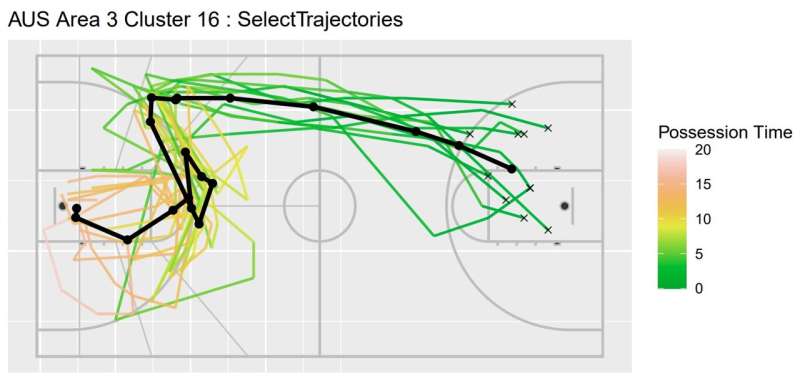Basketball study automates patterns of play to compare teams’ performance

New analysis of elite women’s basketball automatically pinpoints a team’s chances of high or low scoring plays despite the ball’s trajectory looking the same, in research developed by QUT data scientists.
The study, published recently in PLOS ONE, used existing data from 72 women’s international basketball games ranging from the 2014 FIBA World Championships to the 2016 Rio Olympics.
The results provide insights to support coaches to scrutinize teams’ effective or problematic plays by classifying and tracking the dynamics of ball movements as to whether a team scored and relating types of play to scoring outcomes.
While data on spatial characteristics like a basketball’s bounce, its speed, the possession time, points scored as well as previous teams’ history are already wide ranging, research attempting to cluster play types using ball movement is limited.
This new research, applying the concept of ‘dynamic time warping’, was led by Distinguished Professor Kerrie Mengersen and Dr. Paul Wu from QUT’s Center for Data Science, Dr. Wade Hobbs from the Australian Institute of Sport, and University of Sydney and QUT student Alan Yu.
Dr. Wu said the study was prompted by questions about the unpredictability of plays and whether that led to better scoring outcomes.
He said by building on that data and incorporating the trajectory of the ball researchers could investigate how patterns emerged based on the data.
“If we run an identical pick-and-roll play in basketball, executing with the same speed but starting the second play one second later the second time, this will appear like a completely different play to a computer, but a human sees the same play,” he said.
“Dynamic Time Warping provides a way to map one trajectory to another to get a better evaluation of how similar they are automatically.

“This is one way to organize many, many hours of video footage to help coaches and athletes identify key strengths and weaknesses for review and highlight something not obvious like if a team favors one side of the court.”
The data also not surprisingly found fast breaks and greater ball movement, especially changes in direction of ball movement contributed to higher scoring rates.
The project opened an opportunity for QUT data science student Alan Yu to participate during a “vacation semester”.
“I found the experience to be challenging yet rewarding, especially when developing easy-to-understand visualizations that tell the story to people interested in basketball or data science,” he said.
“With not much prior knowledge about basketball, I found the results fascinating and surprising.
“Often you will hear from the coaches and experts analyzing plays and the different tactics and preferences teams may have, but this puts a quantitative touch to understand the sport better in a systematic point of view.
“It was surprising to see similar plays have widely different results when executed by different teams at different speeds.”
Professor Mengersen said the research was a stellar example of what is achieved through partnerships between researchers and industry practitioners.
“The new methods were developed to address an important practical question, and the new insights feed directly back to improve the sports industry,” she said.
“This two-way research benefits everyone and has impact in both sport and new knowledge.”
Yu Yi Yu et al, Classifying ball trajectories in invasion sports using dynamic time warping: A basketball case study, PLOS ONE (2022). DOI: 10.1371/journal.pone.0272848
Citation:
Basketball study automates patterns of play to compare teams’ performance (2022, November 30)
retrieved 30 November 2022
from https://techxplore.com/news/2022-11-basketball-automates-patterns-play-teams.html
This document is subject to copyright. Apart from any fair dealing for the purpose of private study or research, no
part may be reproduced without the written permission. The content is provided for information purposes only.
For all the latest Technology News Click Here
For the latest news and updates, follow us on Google News.

